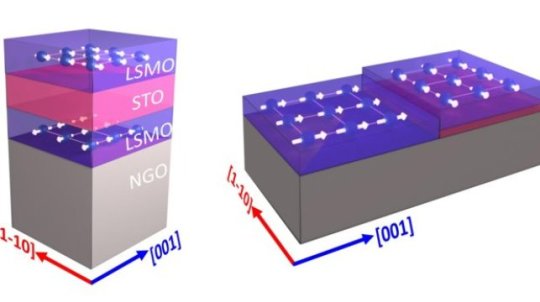
Nanotechnologists are now able to create materials in which they can influence and precisely control the orientation of the magnetism at will. An interlayer just 0.4 nanometers thick is the key to this success. The materials present a range of interesting possibilities, such as a new way of creating computer memory as well as spintronics applications – a new form of electronics that works on the basis of magnetism instead of electricity.
Nanotechnologists at the University of Twente are specialized in creating new materials. Thanks to the top-level facilities at the MESA+ NanoLab they are able to combine materials as they wish, with the ability to control the material composition down to atom level. In particular, they specialize in creating materials composed of extremely thin layers, sometimes just one atom thick.
Computer memory
In research published today in the scientific journal Nature Materials, they show their ability to create new materials within which they can precisely and locally control the orientation of the magnetism. This opens the way to new possibilities of creating computer memory. Moreover, this method of creating materials is interesting for spintronics, a new form of electronics that does not utilize the movement of charges but instead the magnetic properties of a material. This not only makes electronics very fast and efficient, but also allows them to be produced in extremely small dimensions.
Interlayer
In the course of this research the scientists stacked up various thin layers of Perovskite materials. By placing an extremely thin interlayer of just 0.4 nanometres between the layers (a nanometre is a million times smaller than a millimetre), it becomes possible to influence the orientation of the magnetism in the individual Perovskite layers as desired, whereby the orientation of the magnetism in the bottom layer, for instance, is perpendicular to that of the layer above. By varying the location where the interlayer is applied, it becomes possible to select the local orientation of the magnetism anywhere in the material. This is an essential property for new forms of computer memory and for spintronics applications.
This effect was already known for much thicker layers, but never before had researchers demonstrated that the orientation of the magnetism can be controlled so precisely with extremely thin layers, too.
The research has been conducted by scientists of the MESA+ research group Inorganic Materials Science in collaboration with colleagues from other institutes, including the University of Antwerp (Belgium), the University of British Columbia (Canada) and TU Wien (Vienna, Austria). Within the research project, the Twente-based researchers were responsible for coordination and for creating the materials. The colleague researchers from Antwerp visualized the materials and were able to image even the smallest atoms in the material. The Canadian researchers created a magnetic cross-section of the material, while the Austrian researchers handled the theoretical calculations.

 Previous page
Previous page Back to top
Back to top







